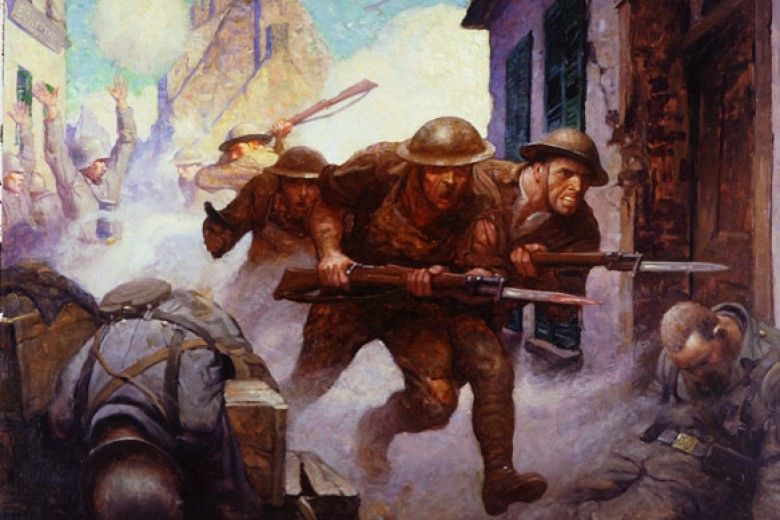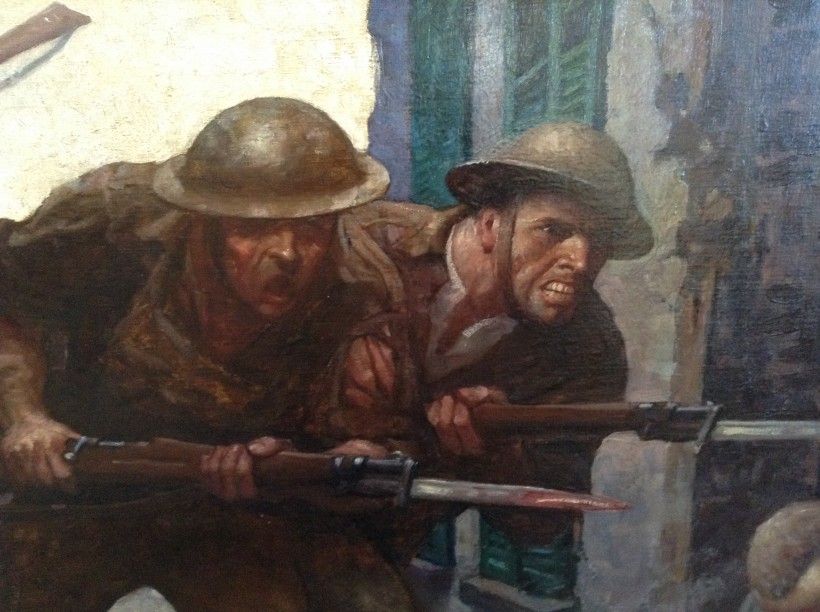First Signs of War

For a few months now, I’ve been fascinated with how World War I influenced the work of both N. C. Wyeth and Andrew Wyeth. Not too long ago, I visited a private collection to look closely at an extraordinary painting by N. C. Wyeth that raises interesting issues faced by many illustrators during the conflict.

The Americans at Château-Thierry is a big painting, three feet high by just a bit less than four feet wide. N. C. Wyeth painted it in late 1918 for the magazine Pictorial Review. It depicts a battle that took place in mid-July of that year, one of the first American victories for General John J. Pershing. Wyeth chose to show, at close range, determined American “doughboys” charging through the streets of a French town, having obviously engaged the enemy with bayonets.
Meeting George L. Linder

Wyeth wasn’t drafted and didn’t visit the front during the war, so he had no first-hand experience on which to base this picture. His letters tell us he was thrilled then when he was introduced to George L. Linder (1889-1960), a veteran of the Chateau Thierry fight, who had been wounded and sent home to nearby West Chester. “It was in search for material that I luckily came across Machine Gunner Linder. We have spent several hours together and he has been here at the house," Wyeth wrote in a letter.
Linder, wounded and no doubt suffering from PTSD, managed to convey to Wyeth a sense of the horrors of the battle, and Wyeth chose to depict two of the doughboys front and center, their grimaced faces registering grisly determination to kill rather than be killed. He tried to suggest the whole range of battle experience—the fire, bombs and smoke; the brutality of hand-to-hand combat; bodies left in the village streets as soldiers rush through. You can almost hear the pounding footsteps of the soldiers, or hear them yelling to comrades above the incredible din of the fight.
The Only Way for Americans to “See”
This image may seem melodramatic to us today, but remember, during WWI there were few photographers embedded with the troops. Americans “saw” the war through photographs in newspapers and through newsreels shown at movie theaters. Much of the film footage and still photography was taken before or after a battle; “live action” photography was still pretty much in the future. In his painting, Wyeth tried to depict as accurately as he possibly could all the sensation and horror of the actual battle in progress. Such an image was often published alongside documentary photographs and considered equally as factual.

If you’d like to learn more about N.C. Wyeth, we have some of his best known works on display at the museum. You can also enjoy the exciting experience of visiting his art studio while you’re here - it is one of our historic properties and an amazing way to learn about N.C. Wyeth’s life, family and, of course, his artwork.